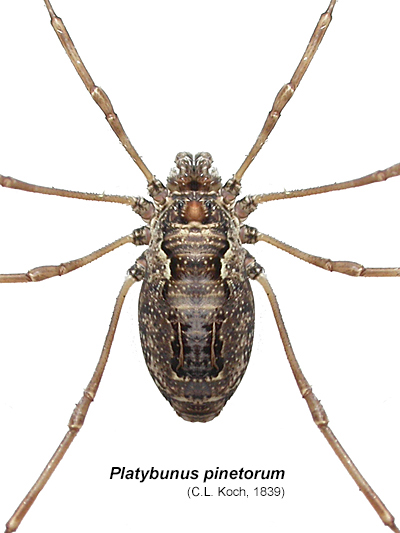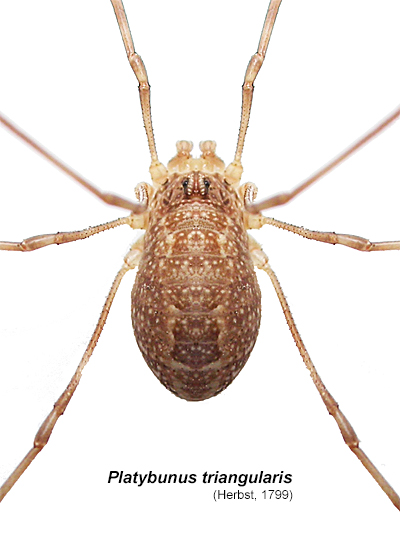

| Platybunus pinetorum - A Harvestman new to Nottinghamshire in 2020 |
| .... |
| On a personal level, one of the overwhelming joys
of invertebrate recording has always been the uncertainty of each trip out. Yes,
admittedly with a degree of preparatory research and a degree of
knowledge, it can be possible on most occasions to have an accurate
expectancy as to what species are likely to be found at a site. But add in the unknown factor, a factor for which invertebrate recording is notoriously capable of adding, and a 'routine' morning's recording, can suddenly be turned on its head. The incredible changes to our national and local climates (easily noticed by anyone older than 30 years old) has led to modern entomologists and naturalists being witness to remarkable changes in our fauna. The changes seem to be ever increasing, no doubt highlighted by the ease and immediacy at which news regarding the latest sightings can be put out via social media. The days us older entomologists can remember, when the latest information dropped through your letterbox already about four months out of date, are (fortunately) very long gone. Social media and invertebrate recording What technology has done for invertebrate recording is difficult to appreciate. Whilst it has undoubtedly created greater awareness and interest in our invertebrate fauna, the downside seems to be an increased tendency to ask the identity of something, without even attempting to identify it yourself. But some invertebrate Orders have benefitted enormously from the greater exposure via the internet and social media. Once considerably neglected and much under-recorded, there has been a dramatic increase in interest shown towards Centipedes, Millipedes, Woodlice, False Scorpions and Harvestmen. |
 |
|
| .... | ||
|
Most Orders have seen a number of species found new to the UK and even the UK's False Scorpion list has just been added to. Its an ever-changing and exciting aspect to recording, but at the same time, it can be a nightmare for those with websites to maintain and update! |
||
| .... | ||
|
Harvestmen (Opiliones) have done well for new arrivals in the past ten or so years, with a number of new species turning up. While many of these new species have originated from southern counties, those of us living in the northern-half of the UK have by no means been left out and with worldwide plant importation to your local garden centre, there's every chance of finding something new to the UK in any part of the UK. Three recent Harvestmen with 'northern roots' include the still un-named Leiobunum sp.A (Schönhofer & Hillen 2008, Toss 2009, Wijnhoven et al. 2007) from Worksop, Nottinghamshire in 2009, Leiobunum limbatum (L.Koch, 1861) from Colne, Lancashire in 2019 and Platybunus pinetorum (C.L.Koch, 1839) from a garden in Sheffield, Yorkshire in 2010. Background history of Platybunus pinetorum in the UK Fortunately, the Sheffield garden in which Platybunus pinetorum was found belonged to Paul Richards, who himself has done much to promote and actively encourage the recording of UK Harvestmen over the past number of years. It was Paul who eventually found the second UK site for Leiobunum sp.A in Barnsley, after Dilys and I had found the UK's first in a small Worksop garden in 2009. For a number of years, Platybunus pinetorum was recorded by Paul (continuing to this day) and then other records began to turn up elsewhere, including locally in Sheffield. Over the next few years, records came from Glasgow and Aberdeen in Scotland, in Northern Ireland and in the UK at Yorkshire, Northampton and a number of other towns. Unfortunately, most of these records have so far failed to find their way on to the NBN Atlas. So after a number of years promoting Nottinghamshire's Harvestmen on this website and then following the excitement of finding a species new to both the UK and Nottinghamshire, Dilys and I were always on the look out for others and Platybunus pinetorum was probably at the top of our list, although we always suspected that the hard to find (and small) Anelasmocephalus cambridgei (Westwood, 1874) lurked in a local woodland somewhere. |
 |
|
| .... | ||
Many of the Platybunus pinetorum records appeared to come from urban locations, so it was along any wall or fence that casual searches were made whenever the opportunity came along. Like the similar Platybunus triangularis, P. pinetorum is one of few Harvestmen to be found as adults during the Spring. P. triangularis is a common species of woodlands and other well vegetated sites, but it has proved to be common at a range of sites and we have recorded it from urban gardens around Nottingham. On the whole, we have found it to be widespread throughout Nottinghamshire, though with few records from sites east of the Trent Valley, which is (without doubt) entirely down to recorder effort. |
||
| .... | ||
|
The
Gleadthorpe find Coincidentally, it was having Anelasmocephalus cambridgei in mind, that I decided to have a wander up to Holborn Hill Plantation on May 16th 2020. Holborn Hill Plantation is an area of mature Beech woodland, which is difficult to come by in Nottinghamshire and we'd always had it down as being a potential site for A.cambridgei. So I thought it would be worth just having a wander and bringing back some suitable leaf litter to sort through later. After parking the car, I began walking and occasionally stopping to photograph the odd thing, mostly as a reminder that I'd seen it and it saves taking a notebook out. I then cut off the main track and began heading towards the Beech woodland, but slowed to have a casual glance before entering the wood, for anything sat sunning itself on the low foliage. As I walked I spotted a Harvestman sat on a Hogweed leaf in typical P. triangularis fashion. |
|
| .... | ||
| I was going to carry on and just put it down to P. triangularis, then thought best to take a reminding record photograph. I never even considered the habitat as being suitable for P. pinetorum, really being swayed by the jealousy-inducing photographs on Facebook, from someone wanting to know if this 'is Platybunus pinetorum stuck on the side of their house'? As I approached to get a photograph, I was immediately struck by the chestnut brown occularium (eye area). To me this was an obvious feature, noticeable even from a meter away. Then noticing the generally darker colouration of this specimen, I knew that I had somehow, accidentally stumbled on the county's first Platybunus pinetorum. | ||
| .... |
|
A pleasant surprise was finding it to be very approachable and unlikely
to bolt. I thought it would (as most inevitably do) and so I did all I
could to reduce the chance of it escaping into the vegetation. In the
end I never needed to and it remained on the leaf, while I detatched it
from the stem to get some less shaky photographs and it spent a few days
in captivity, before being released back at the original location. |
| ..... | ||
| Surveying and recording Platybunus pinetorum | ||
| Harvestmen in Nottinghamshire | ||
| Spiders | ||
| Homepage | ||